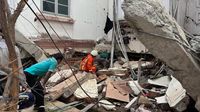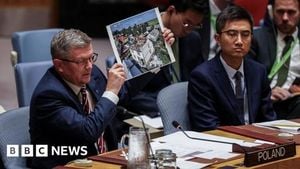On March 28, 2025, a catastrophic 7.7-magnitude earthquake struck Myanmar, sending shockwaves felt across neighboring Thailand and even reaching as far as China. The powerful quake, which was followed by strong aftershocks measuring 6.4-magnitude, has been described as the strongest earthquake to hit Myanmar in over a century. Reports indicate that the death toll could exceed 1,000, with at least 150 confirmed fatalities so far. The devastation has left many trapped under collapsed buildings, and the full extent of the damage remains unclear due to disrupted communication systems and power outages.
As the nation grapples with the aftermath of this disaster, President Donald Trump announced that the United States would assist in the response efforts. During a press briefing, Trump stated, "We’re going to be helping. We’ve already alerted the people. Yeah, it’s terrible what happened." However, the effectiveness of the U.S. response may be hampered by significant cuts to foreign assistance programs implemented during Trump’s administration.
Sarah Charles, a former senior official at the U.S. Agency for International Development (USAID), expressed concerns about the current state of disaster response capabilities. She stated that the system is now "in shambles," lacking the necessary personnel and resources to respond swiftly to crises like this earthquake. Charles pointed out that staffing cuts at USAID have decimated teams that would typically coordinate rescue and recovery efforts in collaboration with international partners.
The quake has caused widespread destruction in Mandalay, Myanmar's second-largest city, where multiple buildings, including a bridge and a monastery, have collapsed. Reports also indicate that a dam near Mandalay burst, exacerbating the situation in lowland areas. Mandalay General Hospital has been overwhelmed with patients, treating many in its parking lot due to the influx of casualties and a shortage of supplies. A state of emergency has been declared across six central states of Myanmar, including Sagaing, Mandalay, Bago, Eastern Shan, Mayway, and Naypyidaw.
In response to the urgent humanitarian needs, Project HOPE has mobilized its emergency response teams to the region. The organization is working to identify supply chain routes for immediate assistance and connect with local organizations to coordinate relief efforts. Arlan Fuller, Director of Emergency Response at Project HOPE, highlighted the dire situation, saying, "This is a historic earthquake in a country that has long had a history of adversity — where millions were already displaced and tens of millions were already in need of humanitarian aid — making the consequences of this disaster even more catastrophic."
Project HOPE’s partner, SAMU, is on standby to deploy mobile medical teams and a search-and-rescue team if requested by the Myanmar government. The organization has extensive experience in disaster response, having previously provided assistance in earthquake crises in Türkiye and Morocco.
As the international community rallies to provide support, the U.S. State Department has indicated that it will utilize requests for assistance and reports from the region to shape its response. State Department spokesperson Tammy Bruce assured reporters that USAID has maintained a team of disaster experts ready to respond. "These expert teams provide immediate assistance, including food and safe drinking water, needed to save lives in the aftermath of a disaster," Bruce noted.
However, the recent announcement from Secretary of State Marco Rubio and USAID official Jeremy Lewin regarding mass firings of USAID staff and the consolidation of agency programs under the State Department has raised alarms about the future of U.S. foreign assistance. Critics argue that these cuts have severely weakened the U.S. response capabilities to international disasters, just as the country faces one of its most significant humanitarian challenges.
The earthquake's impact is further compounded by the fact that nearly 20 million people in Myanmar were already in need of humanitarian assistance prior to the quake, with over 3 million people internally displaced. The disruption of WASH (water, sanitation, and hygiene) services, medication, and food supplies is expected to worsen the crisis.
As rescue and recovery efforts continue, the world watches closely to see how the situation unfolds in Myanmar. With the potential for landslides and further aftershocks, the urgency of the response cannot be overstated. Local authorities have called for international assistance, and the United Nations has already activated its emergency response mechanisms to provide aid.
In Bangkok, the repercussions of the earthquake were also felt, with an apartment tower collapsing and trapping over 100 construction workers. Rescue efforts in Thailand are ongoing, with teams working through the night to locate and free those trapped beneath the rubble.
The international community's response will be critical in the coming days as Myanmar begins to assess the full scale of the disaster. With the current humanitarian needs and the challenges posed by the Trump administration's cuts to foreign assistance, the effectiveness of the response remains uncertain. As support efforts ramp up, the hope is that timely and adequate assistance can reach those affected, helping to alleviate the suffering caused by this devastating earthquake.





